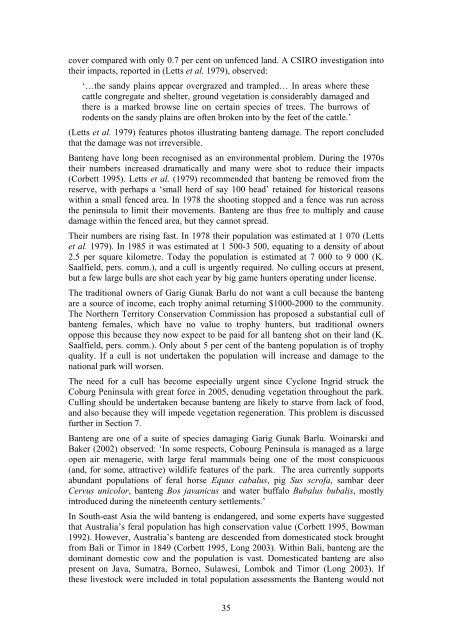Review of the management of feral animals and their impact on ...
Review of the management of feral animals and their impact on ...
Review of the management of feral animals and their impact on ...
You also want an ePaper? Increase the reach of your titles
YUMPU automatically turns print PDFs into web optimized ePapers that Google loves.
cover compared with <strong>on</strong>ly 0.7 per cent <strong>on</strong> unfenced l<str<strong>on</strong>g>and</str<strong>on</strong>g>. A CSIRO investigati<strong>on</strong> into<br />
<str<strong>on</strong>g>the</str<strong>on</strong>g>ir <str<strong>on</strong>g>impact</str<strong>on</strong>g>s, reported in (Letts et al. 1979), observed:<br />
‘…<str<strong>on</strong>g>the</str<strong>on</strong>g> s<str<strong>on</strong>g>and</str<strong>on</strong>g>y plains appear overgrazed <str<strong>on</strong>g>and</str<strong>on</strong>g> trampled… In areas where <str<strong>on</strong>g>the</str<strong>on</strong>g>se<br />
cattle c<strong>on</strong>gregate <str<strong>on</strong>g>and</str<strong>on</strong>g> shelter, ground vegetati<strong>on</strong> is c<strong>on</strong>siderably damaged <str<strong>on</strong>g>and</str<strong>on</strong>g><br />
<str<strong>on</strong>g>the</str<strong>on</strong>g>re is a marked browse line <strong>on</strong> certain species <str<strong>on</strong>g>of</str<strong>on</strong>g> trees. The burrows <str<strong>on</strong>g>of</str<strong>on</strong>g><br />
rodents <strong>on</strong> <str<strong>on</strong>g>the</str<strong>on</strong>g> s<str<strong>on</strong>g>and</str<strong>on</strong>g>y plains are <str<strong>on</strong>g>of</str<strong>on</strong>g>ten broken into by <str<strong>on</strong>g>the</str<strong>on</strong>g> feet <str<strong>on</strong>g>of</str<strong>on</strong>g> <str<strong>on</strong>g>the</str<strong>on</strong>g> cattle.’<br />
(Letts et al. 1979) features photos illustrating banteng damage. The report c<strong>on</strong>cluded<br />
that <str<strong>on</strong>g>the</str<strong>on</strong>g> damage was not irreversible.<br />
Banteng have l<strong>on</strong>g been recognised as an envir<strong>on</strong>mental problem. During <str<strong>on</strong>g>the</str<strong>on</strong>g> 1970s<br />
<str<strong>on</strong>g>the</str<strong>on</strong>g>ir numbers increased dramatically <str<strong>on</strong>g>and</str<strong>on</strong>g> many were shot to reduce <str<strong>on</strong>g>the</str<strong>on</strong>g>ir <str<strong>on</strong>g>impact</str<strong>on</strong>g>s<br />
(Corbett 1995). Letts et al. (1979) recommended that banteng be removed from <str<strong>on</strong>g>the</str<strong>on</strong>g><br />
reserve, with perhaps a ‘small herd <str<strong>on</strong>g>of</str<strong>on</strong>g> say 100 head’ retained for historical reas<strong>on</strong>s<br />
within a small fenced area. In 1978 <str<strong>on</strong>g>the</str<strong>on</strong>g> shooting stopped <str<strong>on</strong>g>and</str<strong>on</strong>g> a fence was run across<br />
<str<strong>on</strong>g>the</str<strong>on</strong>g> peninsula to limit <str<strong>on</strong>g>the</str<strong>on</strong>g>ir movements. Banteng are thus free to multiply <str<strong>on</strong>g>and</str<strong>on</strong>g> cause<br />
damage within <str<strong>on</strong>g>the</str<strong>on</strong>g> fenced area, but <str<strong>on</strong>g>the</str<strong>on</strong>g>y cannot spread.<br />
Their numbers are rising fast. In 1978 <str<strong>on</strong>g>the</str<strong>on</strong>g>ir populati<strong>on</strong> was estimated at 1 070 (Letts<br />
et al. 1979). In 1985 it was estimated at 1 500-3 500, equating to a density <str<strong>on</strong>g>of</str<strong>on</strong>g> about<br />
2.5 per square kilometre. Today <str<strong>on</strong>g>the</str<strong>on</strong>g> populati<strong>on</strong> is estimated at 7 000 to 9 000 (K.<br />
Saalfield, pers. comm.), <str<strong>on</strong>g>and</str<strong>on</strong>g> a cull is urgently required. No culling occurs at present,<br />
but a few large bulls are shot each year by big game hunters operating under license.<br />
The traditi<strong>on</strong>al owners <str<strong>on</strong>g>of</str<strong>on</strong>g> Garig Gunak Barlu do not want a cull because <str<strong>on</strong>g>the</str<strong>on</strong>g> banteng<br />
are a source <str<strong>on</strong>g>of</str<strong>on</strong>g> income, each trophy animal returning $1000-2000 to <str<strong>on</strong>g>the</str<strong>on</strong>g> community.<br />
The Nor<str<strong>on</strong>g>the</str<strong>on</strong>g>rn Territory C<strong>on</strong>servati<strong>on</strong> Commissi<strong>on</strong> has proposed a substantial cull <str<strong>on</strong>g>of</str<strong>on</strong>g><br />
banteng females, which have no value to trophy hunters, but traditi<strong>on</strong>al owners<br />
oppose this because <str<strong>on</strong>g>the</str<strong>on</strong>g>y now expect to be paid for all banteng shot <strong>on</strong> <str<strong>on</strong>g>the</str<strong>on</strong>g>ir l<str<strong>on</strong>g>and</str<strong>on</strong>g> (K.<br />
Saalfield, pers. comm.). Only about 5 per cent <str<strong>on</strong>g>of</str<strong>on</strong>g> <str<strong>on</strong>g>the</str<strong>on</strong>g> banteng populati<strong>on</strong> is <str<strong>on</strong>g>of</str<strong>on</strong>g> trophy<br />
quality. If a cull is not undertaken <str<strong>on</strong>g>the</str<strong>on</strong>g> populati<strong>on</strong> will increase <str<strong>on</strong>g>and</str<strong>on</strong>g> damage to <str<strong>on</strong>g>the</str<strong>on</strong>g><br />
nati<strong>on</strong>al park will worsen.<br />
The need for a cull has become especially urgent since Cycl<strong>on</strong>e Ingrid struck <str<strong>on</strong>g>the</str<strong>on</strong>g><br />
Coburg Peninsula with great force in 2005, denuding vegetati<strong>on</strong> throughout <str<strong>on</strong>g>the</str<strong>on</strong>g> park.<br />
Culling should be undertaken because banteng are likely to starve from lack <str<strong>on</strong>g>of</str<strong>on</strong>g> food,<br />
<str<strong>on</strong>g>and</str<strong>on</strong>g> also because <str<strong>on</strong>g>the</str<strong>on</strong>g>y will impede vegetati<strong>on</strong> regenerati<strong>on</strong>. This problem is discussed<br />
fur<str<strong>on</strong>g>the</str<strong>on</strong>g>r in Secti<strong>on</strong> 7.<br />
Banteng are <strong>on</strong>e <str<strong>on</strong>g>of</str<strong>on</strong>g> a suite <str<strong>on</strong>g>of</str<strong>on</strong>g> species damaging Garig Gunak Barlu. Woinarski <str<strong>on</strong>g>and</str<strong>on</strong>g><br />
Baker (2002) observed: ‘In some respects, Cobourg Peninsula is managed as a large<br />
open air menagerie, with large <str<strong>on</strong>g>feral</str<strong>on</strong>g> mammals being <strong>on</strong>e <str<strong>on</strong>g>of</str<strong>on</strong>g> <str<strong>on</strong>g>the</str<strong>on</strong>g> most c<strong>on</strong>spicuous<br />
(<str<strong>on</strong>g>and</str<strong>on</strong>g>, for some, attractive) wildlife features <str<strong>on</strong>g>of</str<strong>on</strong>g> <str<strong>on</strong>g>the</str<strong>on</strong>g> park. The area currently supports<br />
abundant populati<strong>on</strong>s <str<strong>on</strong>g>of</str<strong>on</strong>g> <str<strong>on</strong>g>feral</str<strong>on</strong>g> horse Equus cabalus, pig Sus scr<str<strong>on</strong>g>of</str<strong>on</strong>g>a, sambar deer<br />
Cervus unicolor, banteng Bos javanicus <str<strong>on</strong>g>and</str<strong>on</strong>g> water buffalo Bubalus bubalis, mostly<br />
introduced during <str<strong>on</strong>g>the</str<strong>on</strong>g> nineteenth century settlements.’<br />
In South-east Asia <str<strong>on</strong>g>the</str<strong>on</strong>g> wild banteng is endangered, <str<strong>on</strong>g>and</str<strong>on</strong>g> some experts have suggested<br />
that Australia’s <str<strong>on</strong>g>feral</str<strong>on</strong>g> populati<strong>on</strong> has high c<strong>on</strong>servati<strong>on</strong> value (Corbett 1995, Bowman<br />
1992). However, Australia’s banteng are descended from domesticated stock brought<br />
from Bali or Timor in 1849 (Corbett 1995, L<strong>on</strong>g 2003). Within Bali, banteng are <str<strong>on</strong>g>the</str<strong>on</strong>g><br />
dominant domestic cow <str<strong>on</strong>g>and</str<strong>on</strong>g> <str<strong>on</strong>g>the</str<strong>on</strong>g> populati<strong>on</strong> is vast. Domesticated banteng are also<br />
present <strong>on</strong> Java, Sumatra, Borneo, Sulawesi, Lombok <str<strong>on</strong>g>and</str<strong>on</strong>g> Timor (L<strong>on</strong>g 2003). If<br />
<str<strong>on</strong>g>the</str<strong>on</strong>g>se livestock were included in total populati<strong>on</strong> assessments <str<strong>on</strong>g>the</str<strong>on</strong>g> Banteng would not<br />
35
















